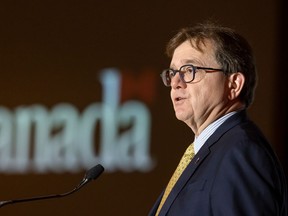Progress on the project is critical for Pathways Alliance to reach its previously announced goal of attaining net-zero emissions from operations by 2050, and for the provincial and federal governments to reach their climate targets

Canada’s Natural Resources Minister Jonathan Wilkinson seemed to be running out of patience with the country’s biggest oilsands producers this spring over the slow progress on their proposed $16.5-billion carbon capture network in Alberta.
Today, the tone has changed.
In fact, Wilkinson hopes an agreement between the Pathways Alliance consortium, Ottawa and Alberta can soon be reached to get one of the world’s largest carbon capture networks moving, perhaps even by year’s end.
On Thursday, Wilkinson and federal Finance Minister Chrystia Freeland met face-to-face in Calgary with members of the oilsands producer group.
Heading into the sit-down, the federal energy minister sounded upbeat.
“The talks that are going on actually have been fruitful over the past few weeks and I’m very hopeful that we’re going to be able to move this ahead in the not-too-distant future,” he said in an interview Thursday.
“I’d probably be going out on a limb to say this year, but ideally it would be before the end of the year — but certainly, if not, early in the new year would be my hope.”
After Thursday’s meeting, officials with the Pathways Alliance — the group includes Cenovus Energy, Imperial Oil, Canadian Natural Resources, Suncor Energy, MEG Energy and ConocoPhillips Canada — called it a “constructive conversation” with the two federal ministers.
Progress on the project is critical for the group to reach its previously announced goal of attaining net-zero emissions from operations by 2050, and for the provincial and federal governments to reach their climate targets.
The carbon capture and storage network would include a 400-kilometre pipeline connecting more than 20 oilsands facilities to an underground storage hub near Cold Lake.
Talks have continued between the group and the federal and provincial governments over incentives that Pathways officials have said would be needed for the megaproject to advance.
The Alberta government has created a program to offer a 12 per cent grant to carbon capture developments.
The federal government has established an investment tax credit for carbon capture, utilization and storage projects across Canada; it would cover up to half of a development’s capital expenses.
Ottawa is also offering carbon contracts for difference (CCFDs) to provide longer-term certainty on the future price of carbon for such developments.
Wilkinson said Pathways has been talking with the Canada Growth Fund, the federal government’s cleantech financing agency.
“We’ve engaged the Canada Growth Fund to work with Pathways to see if there are some additional things that can be done to provide comfort to Pathways with some of the questions that they have,” the minister said.
“I think Alberta is similarly having its own set of conversations about whether there are some additional things they can do to make the project work from an economic perspective.”
“We are engaged with the Canada Growth Fund to determine the most appropriate way to support major decarbonization projects such as ours,” Pathways president Kendall Dilling said Thursday in a statement.
“It is encouraging to see Ottawa taking steps to de-risk industry investments in large-scale carbon capture projects.”

Canada Growth Fund Investment Management CEO Patrick Charbonneau said in a statement it doesn’t comment on whether individual projects are under consideration.
The federal government wants to see Pathways place a firm order for the pipe, which would represent a major capital investment.
“What we’re looking for is a tangible commitment in terms of money that will demonstrate progress. So it could be the commitment around the pipe, it could be one or two projects that moved to FID,” Wilkinson said.
“Remember, this is multiple projects. It’s 12 to 14 different projects that are bundled together. We’re not going to see FIDs for all of the projects right away but, ideally, it would be the ordering of the pipe.”
Finalizing the talks and seeing the project advance would represent a major step forward for the oilsands as it seeks to decarbonize. It’s a large source of greenhouse gas emissions in Canada, coming from the largest emitting sector in the country.
It would also help secure future royalties, taxes, capital investment and jobs for a key part of the economy.
“We are encouraged to hear that Canada Growth Fund and the federal government are engaging with Pathways on a project that has significance in Alberta in ensuring we can increase oil production while reducing emissions,” provincial Energy Minister Brian Jean said in a statement.

It’s been difficult for the parties to strike an agreement because some critics will see it as a subsidy, while industry sees carbon capture as an added cost that doesn’t create economic value, said Richard Masson, former CEO of the Alberta Petroleum Marketing Commission.
For the sector to remain viable during the energy transition, oilsands producers need to demonstrate they can produce oil in the most carbon-efficient manner possible, added Masson, an executive fellow at the University of Calgary’s School of Public Policy.
“If we can get this done, it’s something that will unlock decades of value for Canadians,” Masson said.
The talks also take place as Ottawa is preparing to release draft regulations on an emissions cap on the oil and gas industry, and as the next federal election is moving closer.
“I hope a deal happens,” added Heather Exner-Pirot, director of natural resources, energy and environment at the Macdonald-Laurier Institute.
“It would be great for Alberta, and for the oilsands, and for the country’s emissions-reduction goals to get this settled before the next election.”
Chris Varcoe is a Calgary Herald columnist.